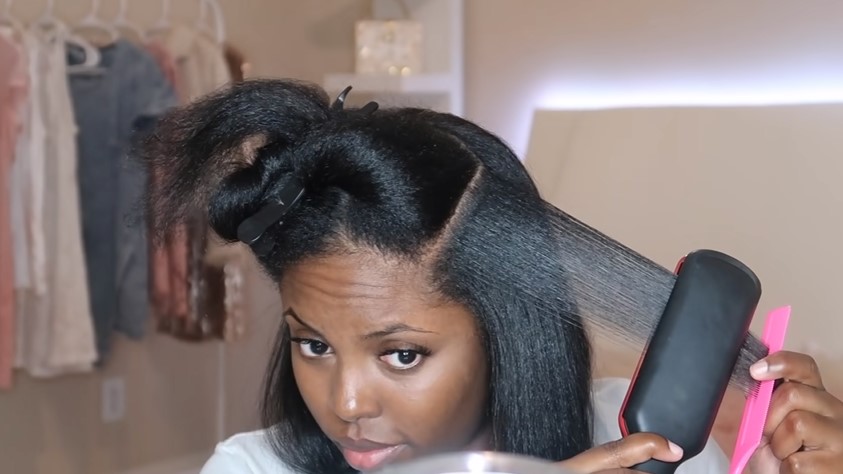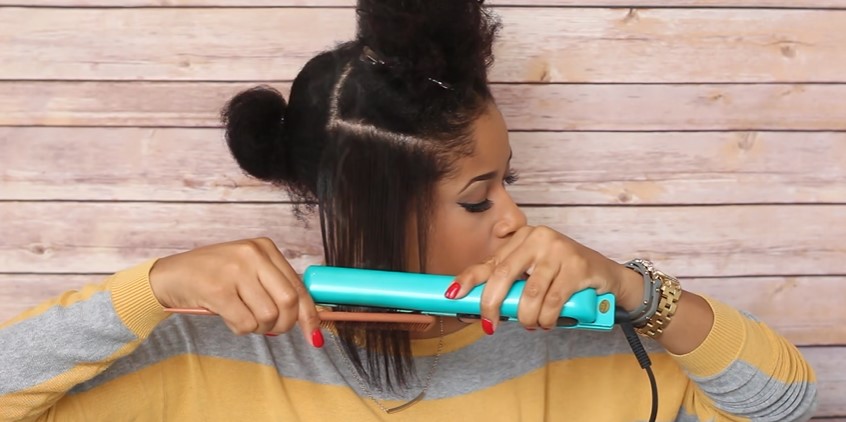Flat ironing your hair is a great way to get the straightened look you want. But it can be difficult to use this tool on natural black hair, and you may end up with breaks or other damage to your strands if you don't know what you're doing. Fortunately, once you follow these steps for flat ironing your hair, then you'll have sleek and beautiful locks that won't damage your curls.
How to flat iron natural hair without damaging it? If you follow these steps, your hair will be straight. You will have the smooth and beautiful tresses you have always dreamed of without the damage that comes with curling irons and blow dryers.
Cleanse the hair shampoo and then deep condition it
Shampoo your hair every week with a sulfate-free shampoo to remove dirt and buildup. Deep condition your hair once or twice a week using a deep conditioner that restores moisture to the hair shaft. Use it after washing your hair, leaving it on for about 10 minutes before rinsing out thoroughly.

Get ready for the ultimate hair cleanse and conditioning with these tips!
Brushing out your hair
The next step is brushing your hair with a boar bristle brush before reaching for your flat iron. Many people skip this step because they think their hair will get tangled in between passes while they're working on it—but this isn't true!
If you brush through your locks every single time before you start styling them, then there won't be any snags or tangles when you get done using your straightener or curling iron... and that means less breakage!
Use only a flat iron on dry hair
Everyone wants long, lustrous, healthy-looking hair. But when you use a flat iron on wet hair, it's not just that you'll get fried strands and breakage—it'll also cause your hair to lose its natural shape, so you'll be fighting with what's left all day long.
An easy rule of thumb is never to use a flat iron on anything but totally dry hair. If you want to take it one step further, you can wait for your hair to be about 80% dry before finishing off the last 20%. This will still prevent some damage from using a hot tool on wet hair, but it's not as strict as waiting until it's bone dry.

Healthy-looking hair starts with the right styling: Say goodbye to fried strands by using a flat iron on only completely dry hair.
When the weather is cold or dry (i.e., winter), it can be tempting to blast your hair with a blow dryer and speed up the drying process—but this can easily damage your hair and cause split ends.
What's more, if your hair is coarse or thick, it'll take a long time to dry straight even when you use heat on it. So if you're rushing around in the morning and have no time for an extended blow-dry session, try wrapping your hair in a towel and sitting under a hood.
Use a flat iron with ceramic plates
While you can use a flat metal iron, we recommend using one with ceramic plates. Ceramic is less damaging than metal, but it's not as effective at straightening your hair. If you want to buy an affordable flat iron that gets the job done without being too heavy on the wallet, go for a metal one with a tourmaline coating.
Avoid Oil Before Ironing
Before flat ironing your natural hair, you must avoid using any oil. You can use oil after ironing; otherwise, the oil will heat up and eventually burn your hair. Oil can make your hair look greasy, and flat irons don't work well on oily hair—so there is no need for that extra step!
And if you're looking for a natural way to protect your tresses from heat damage, plenty of products out there can do the trick.
Apply a heat protectant to your hair before flat ironing it
Before flat ironing your natural hair, you'll want to make sure you have a heat protectant on hand. The product's primary goal is to protect the hair from heat damage and breakage. But, of course, you don't want your flat ironed strands looking unhealthy or brittle after all!
There are tons of products that contain silicones and parabens—two ingredients that can cause build-up in the hair and scalp. Sulfates also tend to be found in most heat protectants, which strip moisture from the scalp and leave a sticky residue on strands (especially true if you live in humid areas).
If you are using sulfates regularly in other products like shampoo or conditioner, this can be especially detrimental—so avoid them whenever possible!
Make sure that whatever product you choose includes one of these words: "free of sulfates/sulfur compounds/sulfites/sulfide release agents/formaldehyde releasers/parabens/phthalates/coal tar derivatives. This means it won't cause build-up on your scalp, leading to itchiness or dandruff over time (plus, it makes your hair look shinier!).
Use lower temperatures if not needed
Use a lower temperature if your hair feels brittle or dry and you want to straighten your curls without permanently changing them. It would be best to never heat a flat iron above 400 degrees for natural hair.
The higher the heat, the more damage you can do to the hair follicles and your scalp. When using an iron or blow dryer on natural black hair, it's always good to start at a lower temperature and work your way up from there.
If you're worried about burning your scalp, wear a shower cap or towel around your head before applying heat. This will help protect your scalp from heat damage while giving you the desired results.
Remember: It's all about finding what works best for YOUR hair type.
Divide your hair into sections
Now that you're ready to start, section off each section of your hair in four parts as you work through them with the flat iron.
As you straighten each section, remember that this is not a race; slow and steady wins the race! You don't want to rush through any areas because it's essential to ensure every curl has been straightened adequately before moving on to another part of your head.
A good rule of thumb is: if you can see curls when looking at your hair from above without having to move too far back or forward from where you stand, stop!!
Work slowly and steady
Work slowly to ensure that you straighten every curl and not just flatten it against your head.
- When flat ironing natural hair, it can take several passes to achieve straightness. So don't rush this process!
- Don't be afraid to go over the same section multiple times. This is especially important if you have thick or tightly curled hair.
- Your goal is to get all of your curls straightened and not just flatten them against your head. If you find that some curls are still curling after repeated passes on one section, try using a higher temperature setting and pressing harder with the flat iron. The key here is not to worry about burning or damaging your hair; if you're careful and take care of it afterward by conditioning regularly (I recommend doing so twice a week), this won't happen anyway!

Prevent breakage and maintain your hair's natural shape: remember to use a flat iron on totally dry hair for gorgeous, healthy-looking locks.
Conclusion
Flat ironing black natural hair is essential to keep it healthy. Flat ironing is one of the most effective ways to make thick and wavy hair straight. The above steps should pull you through straightening your hair without any significant problems.
However, you may still have to do some straightening afterward if the final look is too curly for your taste. It isn't a perfect method nor foolproof—some would say that it hardly gets any more foolproof than simply asking your friend to press your hair with a hot iron.
Still, most ladies don't want their hair to get that damaged. And for them, there is the above method, which takes a little bit of practice but can assuredly achieve the desired results.
When you do this correctly and regularly, your hair will retain its moisture, and you will need the right products to maintain these newly formed curls.